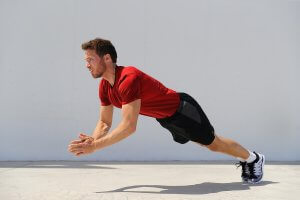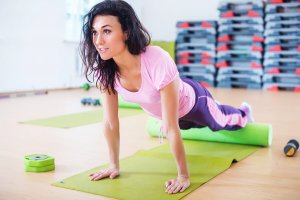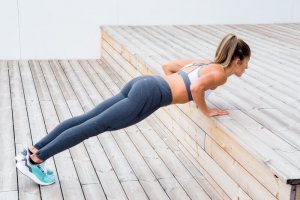Push-up Exercises you Can do at Home

If you think of an essential, practical, and popular bodyweight exercise, push-ups may come to mind immediately. In fact, push-ups are one of the best ways to measure your fitness; and, you can do them anywhere, and almost always without extra equipment. In this article, we’ll discuss the best push-up exercises you can do at home. Choose your favorite!
Traditional push-ups are probably the first exercise that comes to mind when we think of the different types of push-ups we can do at home. However, the key to better fitness is variation.
You can improve your fitness by modifying the exercise slightly to enhance its difficulty. As far as push-ups are concerned, there are many alternatives to the purely classical and traditional form.
Therefore, it’s a good idea to try doing several different types of push-ups to work-out the different parts of your body. This is also important when deciding which variations work best for you.
Push-up exercises you can do at home
While the traditional version is very beneficial, there are actually many different types of push-ups you can do that allow you to exercise different parts of your body. We’ll suggest some examples below!
1. Push-ups with a clap
The first of the push-up exercises you can do at home is a dynamic activity that uses the explosiveness of the upward movement. Basically, you have to clap your hands together after you’ve extended your arms.
This means that, as you raise your body, you really need to use a lot of strength when you push up to give yourself enough time and space to clap your hands before you land back in the starting position and are ready to repeat it.

Don’t forget that you must fall with your elbows slightly bent to absorb the impact. If this is the first time you’ve ever tried this exercise, we recommend that you master the classic push-up first. Once you can do the push-ups with the clap, you should gradually try increasing the number of repetitions.
2. Push-ups with a foam roller
Secondly, we present a type of push-up where you only need a foam roller to support your feet. This will add instability to the exercise since it eliminates direct contact between your feet and the ground. As a result, this exercise also strengthens your abdomen and buttocks.
To begin, you must start with your hands resting on the floor, at shoulder height, and with your toes resting on the foam roller.

From there, bend your arms and lower your chest as close to the ground as possible. Straighten your arms again to go back to your initial position to complete a repetition.
3. Diamond push-ups
If you’re looking for another ideal way to take things up a notch, diamond push-ups are an excellent alternative.
While it’s true that your body’s posture while doing diamond push-ups is similar to when you’re doing traditional push-ups, the main difference is that the hands are much closer together. You need to form a triangle or diamond shape by positioning your fingers. This slight variation causes diamond push-ups to be one of the most difficult to execute.

4. Take advantage of stairs for you to do push-up exercises at home
In this push-up exercise, you must change your body’s angle towards the ground; this will be much more difficult. To do this exercise, you must use a bench or a chair and place it in front of your body.
Next, place your hands on the chair or bench; then, walk with your feet back until you are at a 45-degree angle to the chair.
While you keep your body straight, bend your arms, and lower your chest as close as possible to the chair. Push back to return to the starting position and complete the number of repetitions you deem appropriate.

As you can see, push-ups are one of the best and most versatile exercises to get fit; and, best of all, there are plenty of push-ups variations you can do at home. For that reason, we’re convinced that if you follow this list of exercises, you’ll undoubtedly have fun and see results quickly.
If you think of an essential, practical, and popular bodyweight exercise, push-ups may come to mind immediately. In fact, push-ups are one of the best ways to measure your fitness; and, you can do them anywhere, and almost always without extra equipment. In this article, we’ll discuss the best push-up exercises you can do at home. Choose your favorite!
Traditional push-ups are probably the first exercise that comes to mind when we think of the different types of push-ups we can do at home. However, the key to better fitness is variation.
You can improve your fitness by modifying the exercise slightly to enhance its difficulty. As far as push-ups are concerned, there are many alternatives to the purely classical and traditional form.
Therefore, it’s a good idea to try doing several different types of push-ups to work-out the different parts of your body. This is also important when deciding which variations work best for you.
Push-up exercises you can do at home
While the traditional version is very beneficial, there are actually many different types of push-ups you can do that allow you to exercise different parts of your body. We’ll suggest some examples below!
1. Push-ups with a clap
The first of the push-up exercises you can do at home is a dynamic activity that uses the explosiveness of the upward movement. Basically, you have to clap your hands together after you’ve extended your arms.
This means that, as you raise your body, you really need to use a lot of strength when you push up to give yourself enough time and space to clap your hands before you land back in the starting position and are ready to repeat it.

Don’t forget that you must fall with your elbows slightly bent to absorb the impact. If this is the first time you’ve ever tried this exercise, we recommend that you master the classic push-up first. Once you can do the push-ups with the clap, you should gradually try increasing the number of repetitions.
2. Push-ups with a foam roller
Secondly, we present a type of push-up where you only need a foam roller to support your feet. This will add instability to the exercise since it eliminates direct contact between your feet and the ground. As a result, this exercise also strengthens your abdomen and buttocks.
To begin, you must start with your hands resting on the floor, at shoulder height, and with your toes resting on the foam roller.

From there, bend your arms and lower your chest as close to the ground as possible. Straighten your arms again to go back to your initial position to complete a repetition.
3. Diamond push-ups
If you’re looking for another ideal way to take things up a notch, diamond push-ups are an excellent alternative.
While it’s true that your body’s posture while doing diamond push-ups is similar to when you’re doing traditional push-ups, the main difference is that the hands are much closer together. You need to form a triangle or diamond shape by positioning your fingers. This slight variation causes diamond push-ups to be one of the most difficult to execute.

4. Take advantage of stairs for you to do push-up exercises at home
In this push-up exercise, you must change your body’s angle towards the ground; this will be much more difficult. To do this exercise, you must use a bench or a chair and place it in front of your body.
Next, place your hands on the chair or bench; then, walk with your feet back until you are at a 45-degree angle to the chair.
While you keep your body straight, bend your arms, and lower your chest as close as possible to the chair. Push back to return to the starting position and complete the number of repetitions you deem appropriate.

As you can see, push-ups are one of the best and most versatile exercises to get fit; and, best of all, there are plenty of push-ups variations you can do at home. For that reason, we’re convinced that if you follow this list of exercises, you’ll undoubtedly have fun and see results quickly.
All cited sources were thoroughly reviewed by our team to ensure their quality, reliability, currency, and validity. The bibliography of this article was considered reliable and of academic or scientific accuracy.
- Lehman, G. J., Gilas, D., & Patel, U. (2008). An unstable support surface does not increase scapulothoracic stabilizing muscle activity during push up and push up plus exercises. Manual Therapy, 13(6), 500–506. https://doi.org/10.1016/j.math.2007.05.016
- Lunden, J. B., Braman, J. P., LaPrade, R. F., & Ludewig, P. M. (2010). Shoulder kinematics during the wall push-up plus exercise. Journal of Shoulder and Elbow Surgery, 19(2), 216–223. https://doi.org/10.1016/j.jse.2009.06.003
- Calatayud, J., Borreani, S., Colado, J. C., Martín, F. F., Rogers, M. E., Behm, D. G., & Andersen, L. L. (2014). Muscle activation during push-ups with different suspension training systems. Journal of Sports Science and Medicine, 13(3), 502–510.
- Gouvali, M. K., & Boudolos, K. (2005). Dynamic and electromyographical analysis in variants of push-up exercise. Journal of Strength and Conditioning Research, 19(1), 146–151. https://doi.org/10.1519/14733.1
This text is provided for informational purposes only and does not replace consultation with a professional. If in doubt, consult your specialist.








